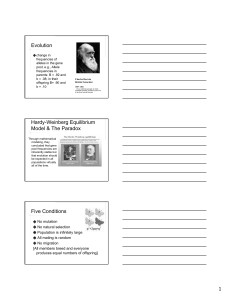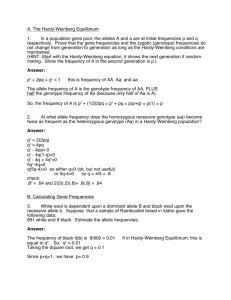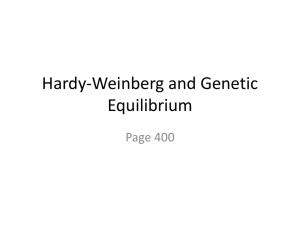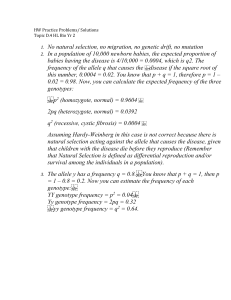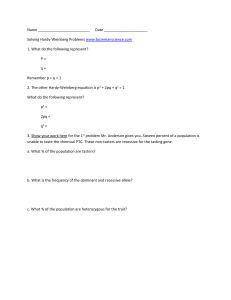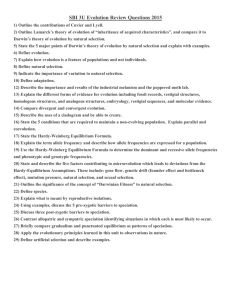ppt
advertisement
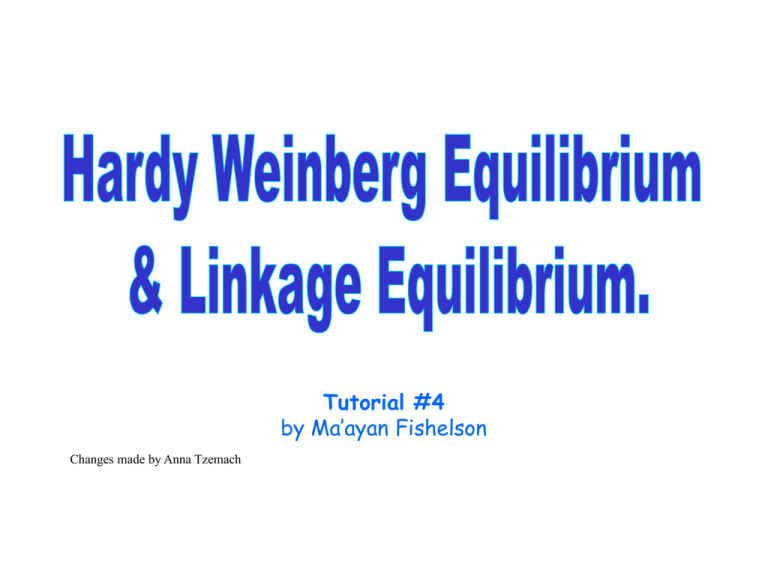
Tutorial #4 by Ma’ayan Fishelson Changes made by Anna Tzemach Hardy-Weinberg equilibrium A||a Other Possibilities: (a||A), (A||A),(a||a) What is the probability that a person chosen at random from the population would have each one of these genotypes ? Hardy-Weinberg equilibrium: If the allele frequencies are P(a)=p and P(A)=q, then, under some assumptions: P(Aa)= 2pq, P(AA)= p2, P(aa)= q2. Corresponds to the random mating of two gametes, an egg & a sperm. Hardy-Weinberg equilibrium This model relies on the following assumptions: a. b. c. d. e. f. g. Infinite population size. Discrete generations. Random mating. No selection. No migration. No mutation. Equal initial genotype frequencies in the two sexes. Hardy-Weinberg equilibrium Let the initial genotype frequencies be: P(A/A) = u, P(A/a) = v, P(a/a) = w. The next generation satisfies: Mating Type Nature of offspring Frequency A/A x A/A A/A u2 A/A x A/a ½A/A + ½A/a 2uv A/A x a/a A/a 2uw A/a x A/a ¼A/A + ½A/a + ¼a/a v2 A/a x a/a ½A/a + ½a/a 2vw a/a x a/a a/a w2 P(A/A) = u2 + uv + ¼v2 = (u + ½v)2 P(A/a) = uv + 2uw + ½v2 + vw = 2(u + ½v)(½v + w) P(a/a) = ¼v2 + vw + w2 = (½v + w)2 Hardy-Weinberg equilibrium If we define the frequencies of the alleles as: • p = P(A) = u + v/2 • q = P(a) = v/2 + w then, the genotype frequencies are: • P(A/A) = p2 • P(A/a) = 2pq • P(a/a) = q2 Second generation respects the same distribution: P(AA)= (p2 + ½2 pq)2 = [p(p+q)]2 = p2 P(Aa)= 2(p2 + ½2pq) (½2pq +q2) =2p(p+q)q(p+q)= 2pq P(aa) = (½2pq + q2)2 = [q(p + q)]2 = q2 Linkage equilibrium A a B b A a B b a a b b A a b b There is no association between alleles at any 2 loci. Linkage equilibrium: P(Aa,Bb) = P(Aa)P(Bb) Hardy-Weinberg equilibrium: P(Aa) = P(A)P(a), P(Bb)=P(B)P(b) Convergence to equilibrium is at the rate of (1 – θ)n. θ = (θf + θm) / 2, where θf and θm are the female and male recombination fractions, respectively. THE HARDY-WEINBERG LAW • p+q=1 • p2 + 2pq + q2 = 1 • p = frequency of the dominant allele in the population q = frequency of the recessive allele in the population • p2 = percentage of homozygous dominant individuals q2 = percentage of homozygous recessive individuals 2pq = percentage of heterozygous individuals Question #1 • You have sampled a population in which you know that the percentage of the homozygos recessive genotype (aa) is 36%. Calculate the following: A. B. C. D. E. The frequency of the “aa” genotype. The frequency of the “a” allele. The frequency of the “A” allele. The frequencies of the genotype “AA” and “Aa”. The frequencies of the two possible phenotypes if “A” is completely dominant over “a”. Question #1- Solution • • • • • The frequency of the "aa" genotype. Answer: 36%, as given in the problem itself. The frequency of the "a" allele. Answer: The frequency of aa is 36%, which means that q2 = 0.36, by definition. If q2 = 0.36, then q = 0.6, again by definition. Since q equals the frequency of the a allele, then the frequency is 60%. The frequency of the "A" allele. Answer: Since q = 0.6, and p + q = 1, then p = 0.4; the frequency of A is by definition equal to p, so the answer is 40%. The frequencies of the genotypes "AA" and "Aa." Answer: The frequency of AA is equal to p2, and the frequency of Aa is equal to 2pq. So, using the information above, the frequency of AA is 16% (i.e. p2 is 0.4 x 0.4 = 0.16) and Aa is 48% (2pq = 2 x 0.4 x 0.6 = 0.48). The frequencies of the two possible phenotypes if "A" is completely dominant over "a." Answers: Because "A" is totally dominate over "a", the dominant phenotype will show if either the homozygous "AA" or heterozygous "Aa" genotypes occur. The recessive phenotype is controlled by the homozygous aa genotype. Therefore, the frequency of the dominant phenotype equals the sum of the frequencies of AA and Aa, and the recessive phenotype is simply the frequency of aa. Therefore, the dominant frequency is 64% and, in the first part of this question above, you have already shown that the recessive frequency is 36%. Question #2 • A temp. dependant enzyme that affects the survival of organisms has 2 alleles (A,B). In a population of 1000 individuals, these alleles have the following frequencies: • A = 0.45 • B = 0.55 The population is exposed to a high temp. which proves to be lethal for all individuals homozygous for the A allele. • Given that the population is maintained at this higher temp., what will be the genotypic and allelic frequencies of the next generation ? Question #2 - Solution • • • • • • • A = 0.45 • B = 0.55 AA = 0.45*0.45 = 0.2025 AB = 2*0.45*0.55 = 0.495 BB = 0.55*0.55 = 0.3025 Expose AB = 0.495/(0.495 +0.3025) = 0.62 BB = 0.3025/(0.495+0.3025) = 0.38 Question #2 – Solution Second generation Mating Type Nature of offsprin g Frequency A/BxA/B ¼ A/A + ½ 0.62*0.62 = A/B+ ¼ BB 0.3844 A/BxB/B ½ A/B + ½ B/B 2*0.62*0.38 = 0.4712 B/BxB/B B/B 0.38*0.38 = 0.1444 • A/A = ¼ *0.3844 = 0.0961 • A/B = ½ *0.3844 + ½*0.4712 = 0.6634 • B/B = 0.1444 + ¼ 0.3844 =0.2405 Hardy-Weinberg Equilibrium for X-linked Loci • Suppose we have two alleles, A1 and A2 with equilibrium frequencies p1 and p2. • The female genotypes have the following frequencies: A1/A1 p12 A1/A2 2p1p2 A2/A2 p22 • In males the genotypes A1 and A2 have the frequencies p1 and p2. Question #3 • The red cell antigen Xg(a) is an X-linked dominant allele with a frequency of approximately p=0.65 in Caucasians. • How many males and how many females carry the antigen ? Question #3 - Solution • dominant allele with a frequency of approximately p=0.65 • In males the genotypes A1 and A2 have the frequencies p1 and p2 => 0.65=> 65% • In females => AA + Aa => 0.65^2 + 2*0.65*0.35 = 0.4225 + 0.455 = 0.8775 Question #4 • Only about 70% of all white North Americans can taste the chemical phenylthiocabamide. • The ability to taste is determined by the dominant allele T. • The inability to taste is determined by the recessive allele t. • Assume that the population is in Hardy-Weinberg equilibrium. • What are the genotypic and allelic frequencies in this population ? Question #5 – Linkage Equilibrium • The degree of Linkage Disequilibrium D can be measured using the following equation: D = PABPab – PaBPAb • What value of D do we expect to see when the population is in Linkage Equilibrium ?

